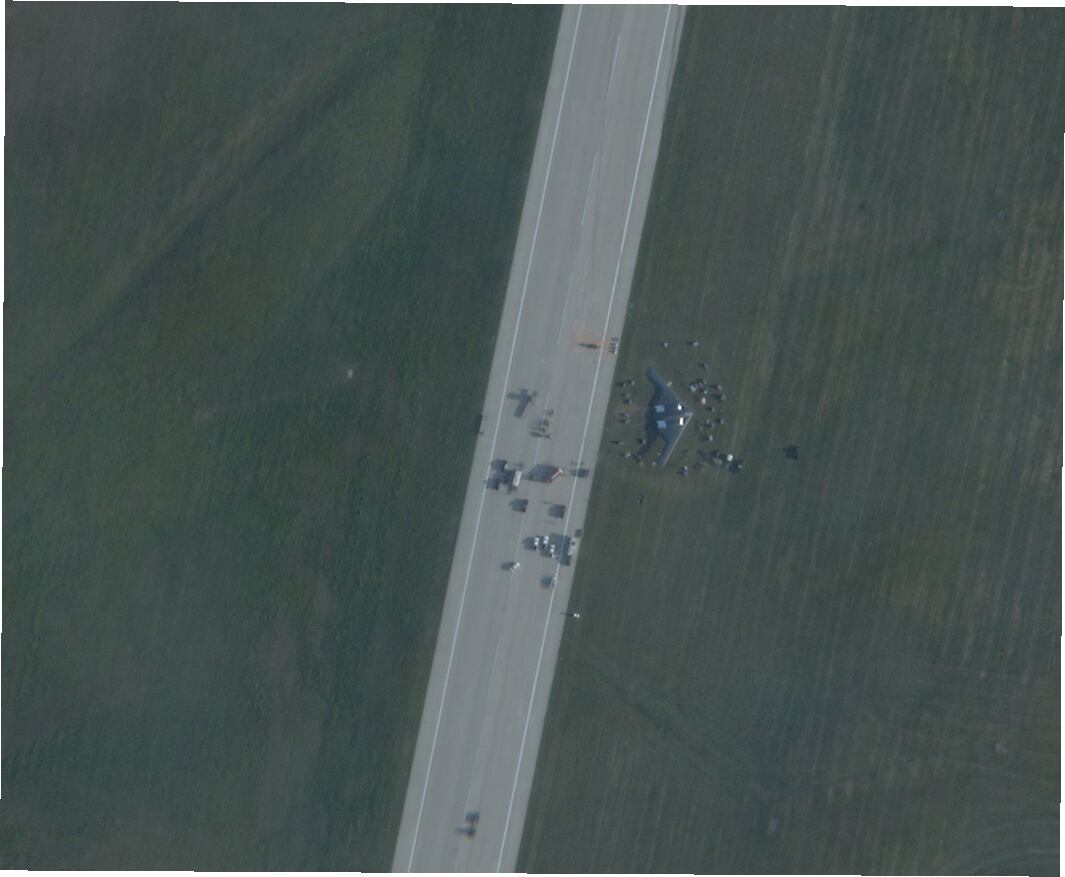Weak springs in a B-2 Spirit stealth bomber led to the collapse of its left landing gear and a skid off the runway as it was touching down at Whiteman Air Force Base, Missouri, in September, an Air Force investigation found.
The two key springs in the bomber’s collapsed left main landing gear didn’t provide enough pressure to keep it in its locked position, according to an accident investigation report that Air Force Global Strike Command released to the public Thursday.
The failure of these springs was the primary cause of the mishap, according to the Jan. 12 report from the investigation board, headed by Col. Robert Cocke.
Those springs hadn’t been replaced in at least a decade — and perhaps never, the report said. In 2018, the Air Force changed the B-2′s maintenance procedures to require these springs to be replaced every nine years as part of regularly scheduled depot maintenance. But this bomber last went into the depot in 2014, before that procedure had been changed. No evidence could be found showing these springs had ever been replaced, investigators said.
An Air Force Research Laboratory analysis of the two springs in the left landing gear found they were outside the tolerance level and producing about 11% less tension than they were designed to provide.
A rapid loss of hydraulic fluid caused by a small metal fatigue crack in a hydraulic coupling unit also kept the bomber from deploying its landing gear normally and was determined to have substantially contributed to the mishap.

The B-2′s left landing gear collapsed within seconds of touching down. Its left wing hit and dragged along the runway as the bomber veered onto the grassy area east of the runway. Both pilots were uninjured and were able to shut down and exit the bomber. No fire broke out.
But the B-2, dubbed the Spirit of Georgia and assigned to the 393rd Bomb Squadron of the 509th Bomb Wing at Whiteman, suffered significant damage to components including its left main landing gear, its door, the skin under its left wing, left lower wingtip light and left lower rudder.
Repair costs were estimated to be at least $10.1 million in the report, but the final cost could end up being much higher: The investigation said engineers need to take a closer look for internal structural damage to its left wing.
The publicly released report does not get specific about the extent of the damage to the bomber’s highly delicate, low-observable stealth coating.
The Air Force has 20 B-2s in its fleet, which cost about $1.1 billion apiece. The Spirit of Georgia was delivered to Whiteman in December 1995.
This B-2 was on its third training sortie of the day when it attempted to land shortly after midnight on Sept. 14, and there were no signs of any hydraulic problems during the first two flights. While on approach, the crew tried to extend its landing gear normally. But almost immediately, a caution light warning of a hydraulic problem lit up, and the pilots declared an in-flight emergency.
The bomber’s right landing gear had experienced a failure of its high-pressure CryoFit coupling, which caused all 21 gallons of hydraulic fluid in one system to drain out within a minute. The bomber automatically switched to a second hydraulic system, and it quickly lost nearly all of its fluid as well. The loss of that fluid also meant a hydraulic lock link actuator was not working and couldn’t help the springs keep the landing gear locked in place.
The pilots started an emergency landing gear extension to make sure all landing gear were down and locked, which uses stored pressure to knock the landing gear into place, and then gravity and airflow to lock it into place with the mechanical lock link system.
The bomber touched down and briefly bounced, though the investigation found it wasn’t a hard landing, and then touched down a second time. Then, without enough spring pressure to keep the left landing gear locked in place, it began to collapse partially back into its wheel well.
The left landing gear door, which remained open during the emergency landing, touched the runway and dragged for about 750 feet before it ripped off, ripping open the skin on the underside of the wing and exposing its internal structure.
The crew struggled to keep the bomber going down the center of the runway, but it dipped to the left, leaving scrape marks from its left lower rudder and wingtip along the runway’s edge. A few seconds later, that rudder also was torn off and slid across the runway.
The bomber’s instructor pilot tried to steer it hard to the right and brake to keep it on course. But the right and left landing gear wheels locked up and the bomber began to veer hard to the left. It left the runway’s eastern edge and came to a stop about 140 feet into the grassy infield.
The report said both pilots were current and qualified in the B-2, and that human factors were not a cause of the mishap.
It remains unclear what, if any, maintenance procedures may be changed as a result of this mishap and the investigation that followed.
Stephen Losey is the air warfare reporter for Defense News. He previously covered leadership and personnel issues at Air Force Times, and the Pentagon, special operations and air warfare at Military.com. He has traveled to the Middle East to cover U.S. Air Force operations.
